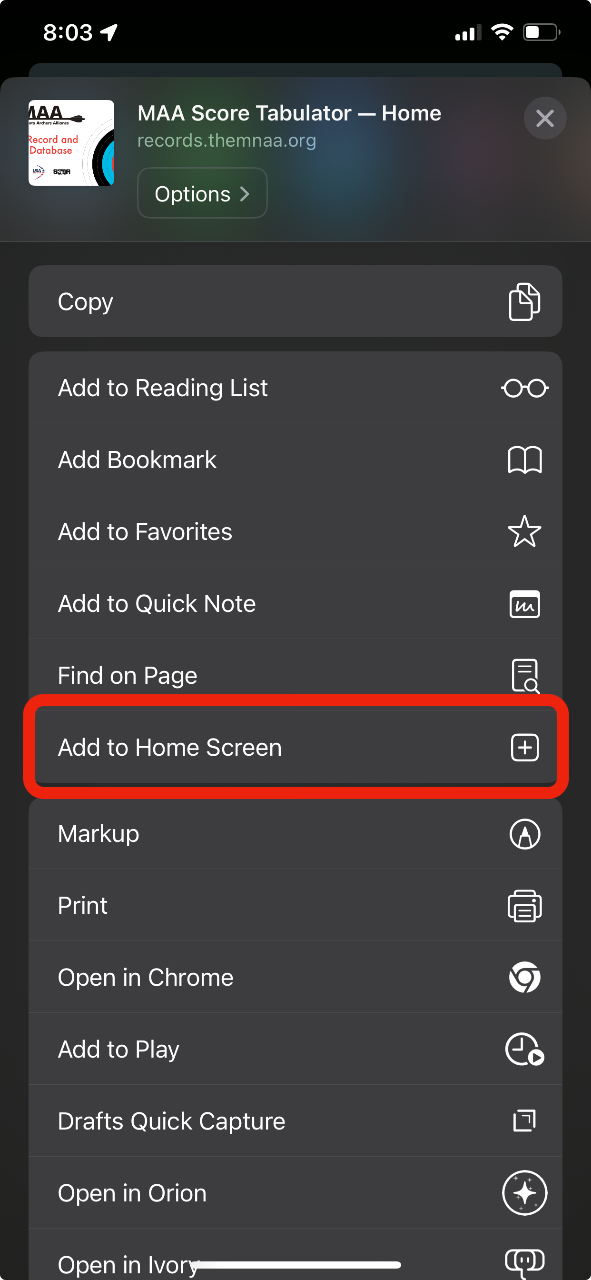How to Use This Site
The score database contains every score recorded by an MAA member in the 20 years of the MAA’s existence. (Well, that’s almost true. There were a few tournaments in the early years for which it was impossible to find results.) In addition to individual scores, podium finishes are available as well.
ClickTap on a link on the home page to view the current state records for that round. When the state record table is visible on a screen too narrow to view the entire table width, a small triangle will be visible on the left side of each row. ClickingTapping on the triangle will reveal the rest of the data.
When viewing a table of state records, try clickingtapping on the division. That will display a ranking of scores for that round in that division. So even if an individual doesn’t hold the state record, you can see where they rank.
Following a link to a person opens their profile page. The profile pages contain tables of the person’s scores as well as any state records or podium finishes they’ve earned. The search box at the top of each page is the quickest way to locate any individual’s profile.
Another new addition to the site is a page for scores from each event. Use the Events link at the top of each page to view a list of all available events. The scores listed on an event page do not necessarily represent the order of finish at the event since some events include archers that are not MAA members and are therefore not included in the database.
Making the site an “app” on your phone
Your smartphone can save this or any website to your home screen so it functions
more like a normal
phone app. Start by tapping on the (iOS) or
(Android) button.
Then you’ll see a menu like one of the following depending on what kind of phone you have:
iOS Share Menu

Android Share Menu

Equipment Classes
The different equipment classes across the NFAA, USA Archery, and S3DA organizations are a frequent point of confusion. While nearly any type of modern bow can find an appropriate class in any organization, the rules and equipment class names vary.
Generally speaking, the equipment class is determined by one or more of the following four criteria:
- Compound or recurve
- Fixed, movable, or no sights
- Mechanical release aid or fingers release
- Stabilizer length (if any)
For the detailed equipment class rules, it’s best to consult the organizations’ websites:
- Book 3, Chapter 11 of the World Archery Rulebook (USA Archery follows World Archery rules.)
- NFAA By-Laws, Article II
- S3DA 2023–2024 General Rules
The following diagram shows the relationship among the various equipment classes. Not all organizations include all types of bows.

Age Divisions
The NFAA, USA Archery, and S3DA all calculate age divisions for competitions differently. Here's a breakdown.
NFAA
The NFAA uses the archer’s age on the first day of the competition, so it’s possible that an archer may start a calendar year competing in one division and change to a different one after their birthday. Archers in the youth divisions may “shoot up” into any age division including adult. Older archers can elect to “shoot down” into the adult division.
The NFAA has professional divisions in the Adult, Senior, Silver Senior, and Master Senior age divisions. Archers younger than 18 can compete as professionals with special permission.
| Division | Ages |
|---|---|
| Cub | Under 12 |
| Youth | 12–14 |
| Young Adult | 15–17 |
| Adult | 18–49 |
| Senior | 50–59 |
| Silver Senior | 60–69 |
| Master Senior | 70+ |
USA Archery
USA Archery calculates age divisions based on the archer’s age on December 31st. As a result, there are never any age division changes during any calendar year. If an archer’s birthday falls on December 31st and that birthday will move them to the next higher age division, they will compete in that age division for the entire preceding year. Like the equipment classes, USA Archery aligns its rules with World Archery, the international archery governing body.
Archers in USA Archery competitions may also shoot up or down into different age divisions. One common point of confusion is that there is no “adult” division in USA Archery competition. The 21–49 group is called “Senior”. The 50+ USA Archery age divisions are called “Master.” In addition, the youth divisions refer to the archer’s age under a certain limit. For example, the Under 18 age division is for archers under 18. If an archery is 18, then they would compete in the Under 21 division.
| Division | Ages |
|---|---|
| U13 | 12 and under |
| U15 | 13–14 |
| U18 | 15–17 |
| U21 | 18–20 |
| Senior | 21–49 |
| Master 50 | 50–59 |
| Master 60 | 60–69 |
| Master 70 | 70–79 |
| Master 80 | 80+ |
S3DA
S3DA calculates an archer’s age division based on their age as of January 1st of the year. Like USA Archery, this means that the archer will compete in the same age division for the entire calendar year. S3DA competitors may also shoot up, but they must submit a form requesting it and must shoot up for the entire year.
Archers who are 19 may compete in S3DA if they are in high school, and 18-year-olds may compete as long as they are not in college. (Taking college classes while in high school is allowed.)
| Division | Ages |
|---|---|
| Junior Eagle | 8 and under |
| Eagle | 9–11 |
| Youth | 12–14 |
| Young Adult | 15–18 |